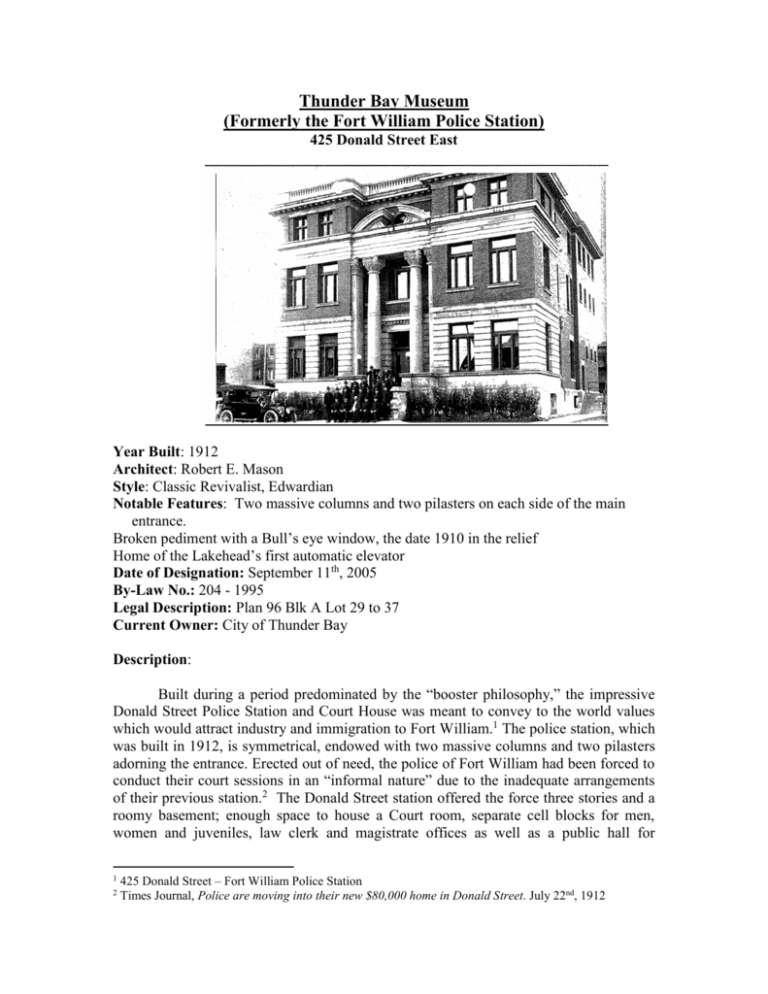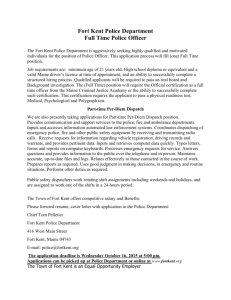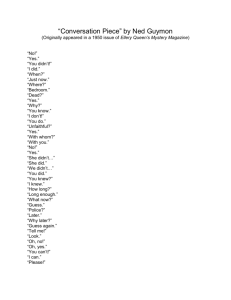Thunder Bay Museum - City of Thunder Bay
advertisement

Thunder Bay Museum (Formerly the Fort William Police Station) 425 Donald Street East Year Built: 1912 Architect: Robert E. Mason Style: Classic Revivalist, Edwardian Notable Features: Two massive columns and two pilasters on each side of the main entrance. Broken pediment with a Bull’s eye window, the date 1910 in the relief Home of the Lakehead’s first automatic elevator Date of Designation: September 11th, 2005 By-Law No.: 204 - 1995 Legal Description: Plan 96 Blk A Lot 29 to 37 Current Owner: City of Thunder Bay Description: Built during a period predominated by the “booster philosophy,” the impressive Donald Street Police Station and Court House was meant to convey to the world values which would attract industry and immigration to Fort William.1 The police station, which was built in 1912, is symmetrical, endowed with two massive columns and two pilasters adorning the entrance. Erected out of need, the police of Fort William had been forced to conduct their court sessions in an “informal nature” due to the inadequate arrangements of their previous station.2 The Donald Street station offered the force three stories and a roomy basement; enough space to house a Court room, separate cell blocks for men, women and juveniles, law clerk and magistrate offices as well as a public hall for 1 2 425 Donald Street – Fort William Police Station Times Journal, Police are moving into their new $80,000 home in Donald Street. July 22nd, 1912 meetings.3 The structure was heralded as the “finest on the continent” for a city the size of Fort William.4 The message conveyed to the world via the Police Station and Court house is one of “solidarity…and security.”5 Ethics also played a part in the creation of this structure; the cells were designed in the “latest and most sanitary style.” Also granting the convicted a measure of dignity, the police station features a side door leading in from an alleyway so that arrestees could be brought in discretely. Especially exciting was the automatic elevator, which did “everything that an elevator boy does except talk, sleep and eat.”6 As the elevator was a new innovation, not only for Fort William, but for “all the land,” a detailed description of the operation techniques had to be written about in the local newspaper. Still, some had their suspicions about the machine; the caretaker believed it to be alive! The elevator isn’t the only supernatural presence said to be felt at the old Police Station. Apparently the ghost of an inmate haunts the building, even after its conversion into the Thunder Bay Museum in 1995. The Museum, which had for decades confronted problems with spacing at its’ numerous different locations finally found a permanent home at 425 Donald Street when, after 83 years in the building, the police station moved to accommodate its’ expanding force. Adding a tasteful addition unto the East side of the building, the Thunder Bay Museum has found a spacious and appropriate home. Architecture: Built in 1910 as a combined Court House and Police Station from a design by R. E. Mason, this three storey building was constructed by Mr. Michael Braden for the then city of Fort William. It is an example of the Edwardian Classical style of architecture which flourished in the earliest years of the 20th Century until WW1 and corresponds to the reign of Britain’s King Edward VII. The classical details of the portico characterizes this buildings official purpose, that of a police station.7 A wide flight of curving stone stairs surrounded by a solid, stepped stone parapet leads to an imposing portico. Subdivided into three sections, the central portion of the façade is recessed and framed by two massive columns. The free standing columns rise two stories and are accented by two pilasters that are attached to the façade wall on both sides of the entrance. The placement of these pilasters gives the impression that there are four columns instead of two, creating an interesting optical illusion. The pilasters are also crowned by carved acanthus leaves and small volutes. The tapered columns are adorned by Roman Corinthian capitals. The columns support a massive moulded architrave which extends across the façade, over the entrance was a pediment with a bull’s eye window. The date 1910 is in high relief. The façade is rusticated stone up to the 2nd floor and the remainder of the façade is faced with Milton brick. Although the windows of the upper part portion of the façade have been altered, the stone sills and lintels remain intact. 3 Times Journal, Police Station and Court House. April 8th, 1911 Times Journal, Police are moving into their new $80,000 home in Donald Street. July 22nd, 1912 5 425 Donald Street – Fort William Police Station 6 Times Journal, Police are moving into their new $80,000 home in Donald Street. July 22nd, 1912 7 425 Donald Street – Fort William Police Station 4 “For Thunder Bay, the building’s architecture portrays a sense of solidarity, authority, prosperity and security. In this way the building is highly representative of a formative period in Thunder Bay’s and Canada’s urban history.”8 Robert E. Mason; Architect Mason arrived in Fort William in 1905, at the age of twenty-two in connection with the survey of the Grand Trunk railway. He became quite prominent in the area as an architect, and “many of the larger buildings stand as a monument to his skill.” He was observed as possessing a “cheery disposition” and was “always ready to say a genial word.” Along with the Police Station, R.E. Mason designed the Fort William Vocational Institution, many of the other public schools in the area, the Kamden apartments, the Masonic temple and a wing of the McKellar hospital. History of Thunder Bay Historical Society: The Thunder Bay Historical Society, which had it’s beginnings in 1908, was founded by Peter McKellar, and received funding from the provincial government in 1910 for $100 dollars per year. This funding proved to be enough to produce annual reports, which have given invaluable insight into the state of Port Arthur and Fort William during these early years. Unfortunately, the funding was discontinued after 1928 and a corresponding gap in annual reports resulted. Only two “bulletins” and one centennial issue (in 1967) were published in the following decades. The Society suffered along with the rest of the area during the Great Depression of the 1930’s. Membership dwindled to only eight, although those that remained were determined to keep the Society alive. Emerging from hard times, the Historical Society was revived with an invitation from the Minnesota Historical Society to participate in the La Verendrye Bicentennial celebration at Grand Portage. This spurred a ‘new phase,’ and forty members enrolled with the Society. Working within the North Shore Historical Assembly, which was comprised of historical organizations from St. Louis, Lake and Cook counties, Minnesota, the history of Thunder Bay and surrounding areas was shared. Despite the growing interest, the Society was without an established location. Meetings were held in the homes of the members, and by the mid 1930’s it became apparent that a space would be needed to house the artifacts being donated to the Society. In 1942 the former smoking room of the Brodie Street Library became available and was utilized by the Thunder Bay Historical Society as a Museum. Within a few short years, however, space was becoming too cramped for the expanding exhibits of the Museum but plans to acquire a larger structure failed. In 1957, the Library built an addition which proved to be adequate accommodation for the Museum for almost a decade. The Thunder Bay Museum was forced to move in 1972, and it found a new home a former registry office. Once again, the Museum outgrew this spatial arrangement and undertook a major campaign in 1995 to acquire and renovate the old police station at 425 8 ibid Donald Street. The major exhibits of the Museum, which opened in 1997, have ample space as additions have been made to the already fair-sized structure. This year marks the 100th anniversary of the Thunder Bay Historical Society, and to commemorate the occasion a special “Now and Then” exhibit is being shown at the museum.









